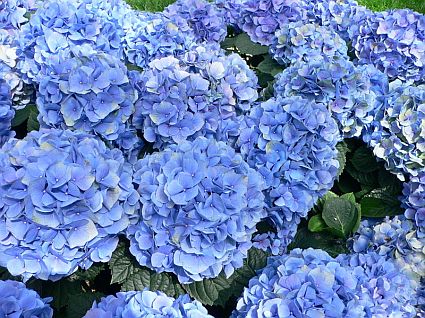How pH affects the color of a hydrangea
By HayLee A. Wax
PINK HYDRANGEA
For hydrangea blooms to be pink, the plants must not take up aluminum from the soil. If the soil naturally contains aluminum, one must try to keep it away from the hydrangea's system. Following are a few tricks that might work:
Add dolomitic lime several times a year.
This will help to raise the pH. Shoot for a pH of about 6.0 to 6.2 (If it goes above 6.4 hydrangeas may experience an iron deficiency). Since hydrangeas take up aluminum best at lower pH levels, raising the pH will help to keep the bluing effect of aluminum out of the hydrangea's system.
Use a fertilizer with high levels of phosphorus.
Phosphorus helps to prevent aluminum from creeping into the system of the hydrangea. Choose a fertilizer close to the ratio of 25/10/10.
In areas that naturally produce blue hydrangeas, consider growing pink hydrangeas in large pots. If hydrangeas are grown in pots, it would be best to use soil-less mixtures, since these mixes would probably not have aluminum in them. In a pot, it will be much easier to control the requirements for growing pink hydrangeas.
BLUE HYDRANGEA
To obtain a blue hydrangea, aluminum must be present in the soil. To ensure that aluminum is present, aluminum sulfate may be added to the soil around the hydrangeas.
Authorities recommend that a solution of 1/2 oz (1 Tbsp) aluminum sulfate per gallon of water be applied to plants throughout the growing season.Important: Water plants well in advance of application and put solution on cautiously, as too much can burn the roots.
To make the aluminum available to the plant, the pH of the soil should be low (5.2-5.5). Adding aluminum sulfate will tend to lower the pH of the soil. Another method for lowering the pH is to add organic matter to the soil such as coffee grounds, fruit and vegetable peels, grass clippings etc.
If the soil naturally contains aluminum and is acid (low pH) the color of the hydrangea will automatically tend toward shades of blue and/or purple.
Extra Information and Ideas
The choice of fertilzer will also affect the color change. A fertilizer low in phosphorus and high in potassium is helpful in producing a good blue color. (25/5/30) is good.
Superphosphates and bone meal should be avoided when trying to produce blue.
Perhaps the best idea for growing blue hydrangeas in an area with alkaline soil would be to grow them in very large pots using lots of compost to bring the pH down. Reduce the strength of the Aluminum sulfate to 1/4 oz per gallon of water. In a pot, it will be much easier to control the requirements for bluing.
It is important to have your water tested so that it will not "contaminate" the soil that you have so rigorously balanced. The pH of the water should not be higher than 5.6.
Planting hydrangeas near a concrete foundation or sidewalk will often affect the color since the pH of the soil may be raised considerably by lime leaching out of these structures, making it difficult to obtain blue.
Links
http://gardenerstips.co.uk/blog/flowers/hydrangea-houseplants/
http://www.enflower.org/entry/change-hydrangea-color-by-modifying-soil-ph/
http://www.usna.usda.gov/Gardens/faqs/hydrangeafaq2.html

